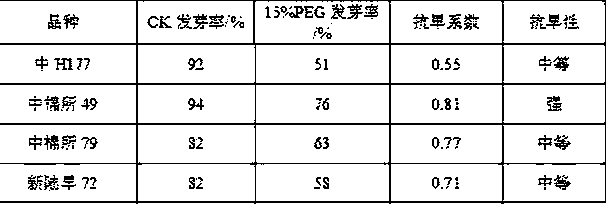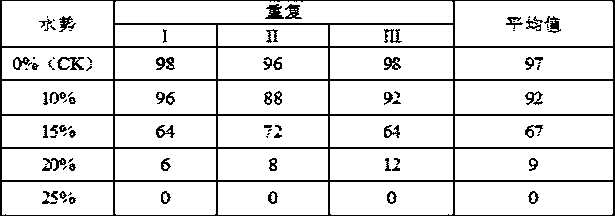Method for authenticating drought resistance of cotton seeds
A cotton seed and drought-resistant technology, applied in the direction of germination equipment, etc., can solve the problems of difficult control of the identification technology environment, long identification period, large human error, etc., and achieve the effects of short identification period, easy promotion and implementation, and easy operation
- Summary
- Abstract
- Description
- Claims
- Application Information
AI Technical Summary
Problems solved by technology
Method used
Image
Examples
Embodiment 1
[0040] Step 1. Sample preparation:
[0041] From the well-mixed net seeds, randomly select 2400 cotton seeds from China Cotton Research Institute 41.
[0042] Step 2. Stress culture: Five concentration gradients of 10%, 15%, 20%, 25% and 30% were set, and each concentration was repeated 4 times, with 100 grains per repetition. Add 20 ml of polyethylene glycol solution of 10%, 15%, 20%, 25% and 30% to each 100 g of dry sand, pH is 6.0-7.5, stir evenly, and spread wet sand with a thickness of 1.5 cm in the germination box. Arrange 4 repeated seeds to be tested on the sand bed evenly, smooth the seeds with a flat-bottomed utensil, make half of them sink into the sand, cover them with a layer of wet sand with a thickness of 1.0cm, and spread them evenly. , cover, and put it in a light incubator at 30 °C ± 1 °C. After the cotyledons are exposed to the sand surface, start to light for 8 hours during the day, and the light intensity is ≥ 1200lx.
[0043] Step 3. Control culture: 4 ...
Embodiment 2
[0057] Step 1. Sample preparation:
[0058] From the well-mixed net seeds, randomly select 800 cotton seeds each of H177, China Cotton Research Institute 49, China Cotton Research Institute 79 and Xinluzao 72. Among them, Zhong H177 is a drought-resistant control variety, and the other three are main planting varieties in the field.
[0059] Step 2. Stress culture: 4 repetitions, 100 capsules per repetition. Add 20 ml of 15% polyethylene glycol solution to each 100 g of dry sand, the pH is 6.0 to 7.5, stir evenly, spread wet sand with a thickness of 1.5 cm in the germination box, and place 4 repeated seeds to be tested. Arrange it on a flat sand bed, use a flat-bottomed container to smooth out the seeds, make half of them sink into the sand, cover with a layer of wet sand with a thickness of 1.0 cm, spread evenly, cover, and place in 30 ℃ ± 1 ℃ In the light incubator, after the cotyledons emerged from the sand surface, the light for 8 h during the day was started.
[0060] ...
PUM
 Login to View More
Login to View More Abstract
Description
Claims
Application Information
 Login to View More
Login to View More - R&D
- Intellectual Property
- Life Sciences
- Materials
- Tech Scout
- Unparalleled Data Quality
- Higher Quality Content
- 60% Fewer Hallucinations
Browse by: Latest US Patents, China's latest patents, Technical Efficacy Thesaurus, Application Domain, Technology Topic, Popular Technical Reports.
© 2025 PatSnap. All rights reserved.Legal|Privacy policy|Modern Slavery Act Transparency Statement|Sitemap|About US| Contact US: help@patsnap.com



